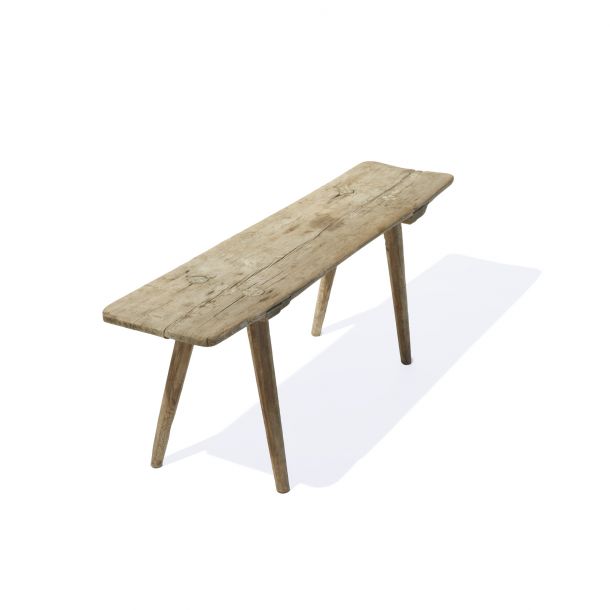About
The Serener.org collection is initiated by designer Christoph Seyferth in 2008. Christoph intends to (re-)search the intrinsic quality of anonymized design, which can be found in products that usually are not associated with ‘design’. A Serener.org product acts as a well-made tool: because of the opportunities it offers, it’s being used and cherished again and again.

It wasn’t nostalgia that caused it all. Nor was it a longing for a world gone by, when people surrounded themselves with objects considered to be superior, because they were still infused with artisanal innocence. In that respect the idea for the Serener.org collection does not originate in conservatism, or from some kind of angst-driven nostalgia that champions the restoration of simplicity.
Nevertheless all these negations seem to be part of the story Christoph Seyferth narrates with this unfinished, ongoing family of objects. His bed, room divider screen, wedding chest, adjustable lamp...objects with a predictable, well-nigh archetypical austerity. If one would falsely apply such specific notions as ‘craft’, ‘innocence’, ‘desire’, ‘restoration’, and ‘austerity’, then the whole Serener.org project could be considered to be an anachronistic attempt to declare the Arts & Crafts movement as contemporary design’s primary foundation: back to the pre-industrial world, back to the noble craftsman.
This confusion and possible misunderstanding evoked by his design language is exactly what Christoph Seyferth toys with while gradually defining the different actors in his collection. They are both obvious and complex. He seems to lure the onlooker into drawing premature conclusions. Those that deem themselves to be insiders in the world of contemporary design are tempted to pigeonhole these objects into simplistic adjectives: traditionalist, crafty, anti-industrialist, perhaps even anti-intellectual.
Off target! The so-called insider only eyeballed his own flawed reflection and paradigm in the mirror, a paradigm that holds the design discourse hostage by means of endless reflections that attempt to stress the importance of a conceptual stance vis-à-vis an influential market, and, in that respect, between fine art and economy. Such debates cloud the much more urgent notion of the sustainable importance of products in our present environment. Is our home a permanent display of the genius of others or an environment in which the occupant has the tools in order to create meaning himself?
Applying a design language and grammar that are deceptively recognizable, Seyferth questions with Serener.org the very legitimacy of ‘design’, which is comparable to the way poets research the essence of poetry in their work. Is design still about creating essential products, or has it lost itself in creating ephemeral temptations? Is designs’ added value nothing more than a redundant gift wrapper? Has the nightmarish prospect of the ‘design beautifier’ become reality?
The history Christoph Seyferth relates to with Serener.org is that of human ingenuity. If there happens to be a historical point of reference in this, then it is Seyferth’s affinity with a seemingly timeless, anonymous farmer’s stool he discovered as an eighteen-year-old in the Dolomites, and which is with him ever since. This is not an act of conservatism, but rather the acknowledgement that not only during the past decades there was sound thinking about the form and function of human appliances.
Of course Seyferth realizes that referring to such a stool will elicit stereotypic responses. That’s the reason why the Dolomite stool is the Serener.org collection’s ongoing physical anchor point, precisely to underline his mission to go beyond celebrating his own unicity. The stool contrasts strongly with all the ‘author’s design’ that fills museums, galleries and magazines. The same is true for the products that Seyferth is currently working on. These products are not made to ‘tell a story’. They simply tell us what they are: a table, a bed, a room divider screen...cleverly made with subtle details but never densified to the point of becoming a closed universe. Such a sturdy product behaves like a tool; it invites to be used and caressed, not for what it is but for what it triggers.
Each part of the collection has the openness of a tool. It is sustainable because it has been produced with the proper materials and techniques. Seyferth uses innovative technologies, since resorting to the traditional craftsman’s toolbox is seldom an option. The products have been designed in such a way that physical use adds quality in the course of time. In determining the object’s shape and finish simplicity is the guiding principle: just what it needs to make the product effective as tool. There is no ambition to make the product hermetic. Quite the contrary.
Ultimately the products are comparable with the basic ingredients in an environment, which, through the user’s intervention, generate meaning. The more the products tempt him to act, the better the designer has done his invisible, unassuming job. Maintain openness: that is what Serener.org strives for. Blank, but far from being devoid of content.
Serener.org presents products with a modest but decisive presence. They are silent when speaking is not absolutely necessary. Their value is revealed when used. Form and function are reduced to the absolute essence to such a degree, that these products will prevail in any given environment, from nomadic to high-tech.
With this collection, which also might imply an invitation to designers with a similar attitude, Seyferth reveals a designership that ultimately proves to be more sustainable than today’s ubiquitous Ego stances.
As long as both users and design specialists are willing to put the various notions and their connotations in the right context, the Seyferth story, again, is not about nostalgia or lost innocence, but about openness and sustainability as quintessences for a full-fledged, future-oriented designership.
Gert Staal, 2009